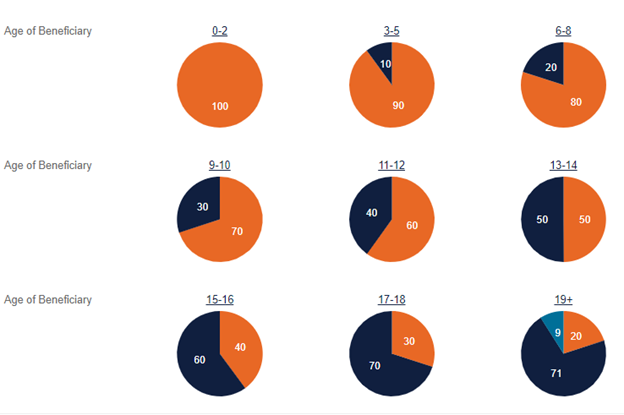
As a parent, you have a lot on your plate. Preparing for college costs is unlikely to be your top priority. However, with college education costs having skyrocketed over the past few decades and the application process becoming ever more competitive, it is never too early to begin thinking about your child’s college education.
In this three-part article series, we will help you understand this lifecycle and provide you with strategies for managing the challenges it poses for families. We will examine three stages in our series as follows:
- Stage 1: The Early Years
- Stage 2: The High School Years
- Stage 3: Grandparents Can Help, Too
Stage 2: High School
A Time for Additional Financial and Non-Financial Investments
In part two of this guide, we discuss some important considerations for families whose children are approaching college age. As with any financial planning topic, there is no one-size-fits-all approach to managing college expenses, so we encourage you to contact us to discuss your unique situation and to develop an individualized plan for meeting this financial goal. In this article we explore college savings investment strategies, as well as when and how to withdraw funds from your college savings accounts to maximize their usefulness. We then conclude with a high-level discussion of some key college admissions elements for parents of college bound high school students to consider.
Preparing For College Costs
Investment Risk Management
As with all financial goals, risk management is a key component to long term success with college savings. Finding an appropriate balance between return potential and your own personal tolerance for risk will be necessary for reaching your college savings goals. When first establishing your college savings plan, investing in a high risk/high reward strategy focused primarily on stocks may be the prudent thing to do. However, as your child enters high school and your end goal of funding your child’s college education comes into sight, such an allocation may no longer be appropriate. As you enter into this phase of college planning, you should consider reviewing the asset allocation of your 529 plan or other college savings investment accounts and make any necessary adjustments to accommodate withdrawals in the next few years.
During your child’s final years of high school, your college savings portfolio needs to become considerably more conservative in our view; we generally recommend lowering the portfolio’s exposure to stocks to around 20-30%. This should help protect your savings from a sudden drop in the market, which could have severe adverse impacts with the need for funds so close.
The Diagram below from Vanguard and Bright Start Savings illustrates how an investor might change their portfolio over time as their client gets closer to college age.

Orange represents stocks, navy represents bonds, blue represents cash. Source: https://brightdirections.com/investment-options/age-based/
Investment Withdrawal
As the actual costs of your child’s higher education begin to take shape, you should begin thinking about how to maximize the value of your college savings. Deciding which accounts to use is a critical step in this process. You will need to begin by calculating your anticipated qualified higher education expenses. These are typically items such as tuition, fees, books, supplies, room and board, and computers. If you have saved into a 529 plan for your child, the plan will offer tax-free growth and tax-free withdrawals if the funds are used to pay for qualified expenses. Using 529 plan dollars for these expenses will help maximize the plan’s tax advantages. At the same time, you should plan to use funds from other sources, such as custodial accounts, to cover other common college expenses that are not considered qualified, such as travel expenses, cell phone plans, and health insurance premiums. Working with a financial advisor to develop an appropriate withdrawal plan can help you maximize the value of your savings.
Preparing for College Applications
The Admissions Roadmap
Having a sound plan for funding your child’s college education is obviously important, and that plan becomes even more crucial as your child enters high school and that far-off vision of sending him or her away to college starts to come into focus. However, the cost of college should hardly be the only concern for families with college bound students. There are a number of other items that families of college bound students should consider in order to increase their student’s chances of success, not just in the complex and competitive college application process but also throughout their college experience.
There are high school students who choose to take an alternative path to college, but the majority plan to matriculate directly after completing high school. To help navigate the admissions roadmap, and gain a high-level view of the admissions process, here is a top 10 list of elements to be navigated by families with college bound students.
- Writing– Written communication is an underdeveloped skill in many college bound students these days. Developing muscle in writing prior to high school can be helpful. Look for summer courses or school electives to strengthen areas of expository, persuasive, narrative, and descriptive writing. How well one develops concepts, theories, or opinions through the written word is evaluated on college essays and applications.
- Rigor –Colleges scrutinize high school course choices and the associated rigor and GPA trend maintained through a student’s senior year. The high school transcript tells an accurate story when evaluating college academic readiness. Choose courses, in school or outside of school, that highlight strengths and interest areas, ultimately creating a profile that aligns with how a student wishes to be perceived as a prospective student.
- Resume – A competitive academic and extracurricular resume stands out in an applicant pool. Athletics, clubs, and mission trips are great, but colleges want to see connections between a resume entry and devotion to the activity by the student. Never waste a summer. It’s all about engaging in something that stirs your passion and gives you hands-on experience.
- Campus visits– Historically, physically roaming a college campus and touring the halls has been the way to get a “feel” for a college. The wave of the future has ushered in Zoom virtual tours, web-based Q&A sessions, and online admissions chats. Evaluating pros and cons of program size, distance from home, online course offerings, Greek life, religious or political preferences, etc. all help to refine the list of schools for application.
- Testing – Standardized college testing has come under fire lately, and the future is still unclear. Worldwide, the ACT and SAT have been the standard. There are other tests, including Subject Tests, International Baccalaureate, and Advanced Placement, and each has a unique focus in measuring competency and college readiness. Applying “Test Optional” is becoming popular. However, it is not necessarily a good option for every student. Refrain from being penny-wise and pound-foolish when it comes to test prep. Test prep tutoring from a professional with a solid track record often yields less student anxiety and better overall score results.
- College search– We encourage our clients to make productive researching for college a priority. Rankings that list Ivies and big-name schools can be deceiving and typically omit many excellent college options. Research should compare and contrast offerings like majors, clubs, study abroad, program research opportunities, and scholarship options. Relevant to college expenses, co-op and work study programs are excellent ways to blend learning with offsetting costs. Tools such as net price calculators, college cost comparison guides, and published admissions trend data are valuable when comparing admission and cohort trends, as well as merit aid and scholarship awards. If a student is not prepared for college right after high school, a gap year or deferring enrollment are worth exploring.
- Money – Scholarships are a reality for many but not all. Scholarships fall into several categories, including merit, federal/state/institutional grants, local community, special interest and non-profit, and NCAA Division 1 and 2 athletics. With regard to loans: parents and students can secure loans to pay for college. Some available options include PLUS (Parent Loan for Undergraduate Students) and unsubsidized/subsidized Stafford Loans. Get educated early in the process to determine what are reasonable considerations for your family. If ensuring a student has “skin in the game” is a goal, options could include campus employment, work study, or a Stafford Loan. Stafford loans have the additional benefit of deferring cost and building credit in a post-graduate student’s name.
- Application Components – The physical submission of applications has become a tedious process with fluctuating requirements and inconsistencies among colleges. The best approach hinges on the student’s preferred target deadline for each prospective college. The combinations vary related to deadline options so students should educate themselves on terms like “Early Decision,” “Early Action,” “Restrictive Early Action,” and “Test Optional.” Physical application options are primarily online and include the Common Application, Coalition Application, and school specific applications. A common requirement is submitting a response to an essay prompt. Choose a topic that allows the student to showcase his or her best attributes. It is advisable to enlist the help of teachers, parents, or college professionals to ensure a final essay submission is spot-on. Recommendation letters are not required by all colleges, but they are often allowed. While standard recommendation letter providers include guidance counselors and teachers, individuals like employers, athletic coaches, or church leaders may lend valuable insight to admissions. An interview is a good option if you are not a strong writer or tester, have an academic hiccup, a disciplinary record blemish, or a learning difference that needs explanation, seize control of the narrative. Additionally, college alumni conversations not only afford prospective students unique access, but the post-interview feedback to admissions teams can impact admit decisions.
- Learning differences–Does the student have a documented learning difference or Individualized Education Program (IEP)? Petitioning for accommodation in college may be advantageous. Update any professional assessments, evaluations, and related paperwork confirming diagnoses in case they are requested.
- Financial Aid Forms–Whether a family can afford to pay for college or not, most appreciate not having to pay full price. We recommend families assess any benefits to filing a FAFSA, CSS Profile, and/or school-specific verification forms. Will a family have more than one child in college at the same time? Or will a parent and student be simultaneously enrolled full-time in school? Families should discuss financial strategies no later than the eldest child’s high school freshman year.
Many friends and family are keen to offer well-intentioned advice as you navigate high school and plan for college. We would suggest introducing experienced professionals into the mix of people you consult before making a huge financial decision such as college. When your student lands that desired future acceptance letter, we think you’ll be glad you followed expert advice.
This article is prepared by Pekin Hardy Strauss, Inc. (“Pekin Hardy”, dba Pekin Hardy Strauss Wealth Management), for informational purposes only and is not intended as an offer or solicitation for business. The information and data in this article does not constitute legal, tax, accounting, investment or other professional advice. The views expressed are those of the author(s) as of the date of publication of this report, and are subject to change at any time due to changes in market or economic conditions. Pekin Hardy cannot assure that the strategies discussed herein will outperform any other investment strategy in the future, there are no assurances that any predicted results will actually occur.

